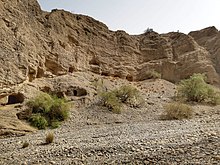 | |
 | |
| Alternative name | Shehr-e-Roghan, Cave City of Gonrani, Cave Dwellings of Gondrani, House of the Spirits, Mai Goudrani |
|---|---|
| Location | Bela, Balochistan, Pakistan |
| Region | Balochistan |
| Coordinates | 26°23′39″N 66°12′45″E / 26.39417°N 66.21250°E / 26.39417; 66.21250 |
Gondrani (Urdu: گونڈرانی), also known as Shehr-e-Roghan (Urdu: شہرِ روغان), is an archaeological site near the town of Bela in Balochistan, Pakistan. Situated 20 kilometres (12 miles) to the north of the town of Bela and approximately 218 kilometres (135 miles) from Karachi, it lies within the Lasbela District. Renowned for its unique features, the site is also known by several evocative names, including the Cave City of Lasbela, the Cave Dwellings of Gondrani, the House of the Spirits, and the town of Mai Gondrani.
History

The exact history of the town is not known, nor who built the caves. Historians believe that the town was once a large Buddhist monastery dating back to the eighth century, when the region was part of a Buddhist kingdom. André Wink in his book Early Medieval India and the Expansion of Islam: 7th-11th Centuries states that:
In effect, at eighteen km north-west of Las Bela, at Gandakahar, near the ruins of an ancient town, are the caves of Gondrani, and as their construction shows these caves were undoubtedly Buddhist.
According to another source, Journal of the Society for South Asian Studies, the site cannot be conclusively linked to Buddhist heritage, though it does show Buddhist characteristics:
Although not irrefutably Buddhist, the cave complex of Gondrani, some fifteen kilometres north-west of Las Bela in Makran, does show definite Buddhist characteristics.
The Geographical Journal agrees that the caves are of Buddhist origin:
...not far from them are the Caves of Gondrani, about which there is no room for conjecture, for they are clearly Buddhist, as can be told from their construction.
Caves of Gondrani
The Caves of Gondrani are locally known as Puraney Ghaar, simply translating to ‘Old Caves’. (Urdu: پرانے غار),
They are carved into solid conglomerate rocks at several levels, and are connected by pathways. All the caves have small rooms with hearths and wall niches for lamps, along with verandahs or front porches.
During British rule, around 1500 caves were reported, but now only 500 remain. The caves are in poor condition and are slowly eroding. No conservation efforts have been made to protect the site due to poor accessibility and lack of knowledge of the archaeological site.
Legends
Many local legends are associated with the town. One relates the story of a king and his daughter, named Badiul Jamal, during the reign of king Solomon, who was haunted by demons. Many heroes came to free her and failed, but eventually Prince Saif-ul-Muluk killed the demons and freed her. According to another legend, the demons and evil spirits inhabiting the mountain would torment and feed on the flesh of the people of Gondrani. An old holy woman named Mai Gondrani sacrificed herself to kill the demons and free the town people. In another version, the pious lady exorcised the town and lived there until her death. The woman is buried nearby; her burial place is a well-known local shrine.
See also
References
- ^ Rashid, Salman (1992). Riders on the wind: Travels through Pakistan. Sang-e-Meel Publications. p. 113. Retrieved 22 March 2013.
- ^ "Lasbela". Explore Balochistan. Government of Balochistan. Archived from the original on 1 June 2012. Retrieved 19 March 2013.
- ^ "House of the spirits". The Express Tribune. 19 February 2012. Retrieved 19 March 2013.
- ^ Royal Geographical Society (Great Britain) (1896). John Scott Keltie (ed.). The Geographical Journal Volume 7. Great Britain: Royal Geographical Society. p. 399.
- Wink, André (2002). "The frontier of alHind". Al-Hind : the making of the Indo-Islamic world (. ed.). Leiden: E. J. Brill. p. 135. ISBN 978-0391041257. Retrieved 19 March 2013.
- Taylor & Francis (1989). South Asian Studies: Journal of the Society for South Asian Studies. University of Michigan: The Society for South Asian Studies.
- "Lasbela" (PDF). District Development Profile 2011. Govt. of Balochistan. p. 10,11. Retrieved 19 March 2013.
| Cultural heritage sites in Balochistan, Pakistan | |
|---|---|
| Forts | |
| Tourist spots | |
| Archaeological sites | |
| Other sites | Bara Bagh Cemetery, Lasbela |
| History | |
|---|---|
| Government and politics | |
| Culture and places | |
| Archaeological Sites | |
| Geography | |
| Education | |
| Sport | |